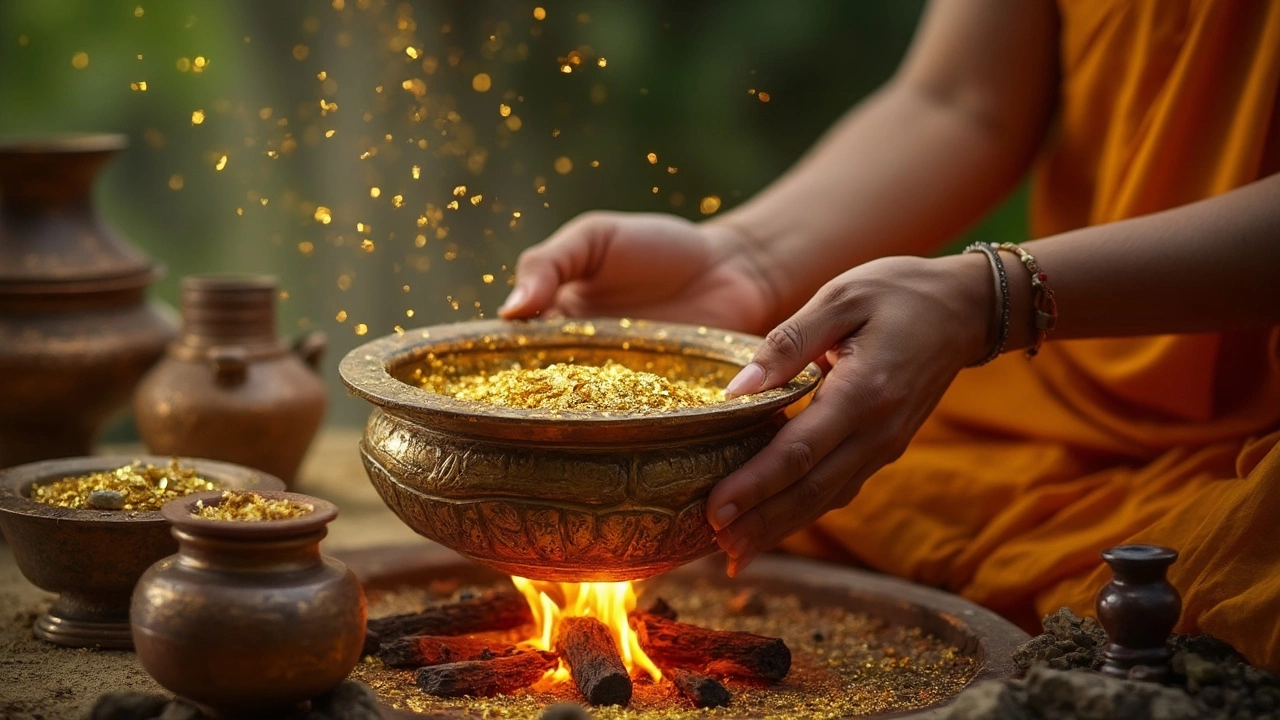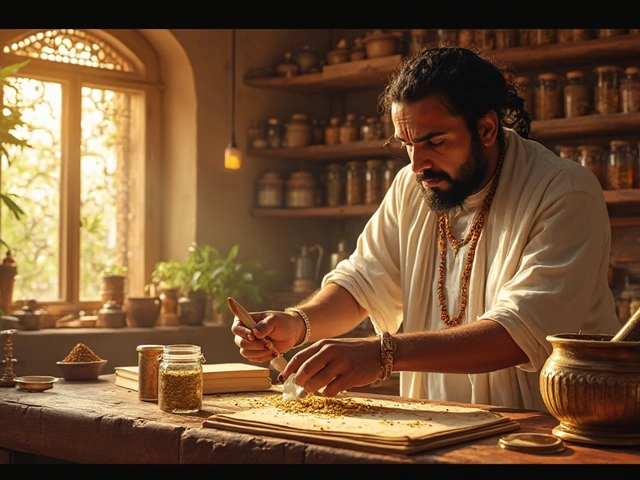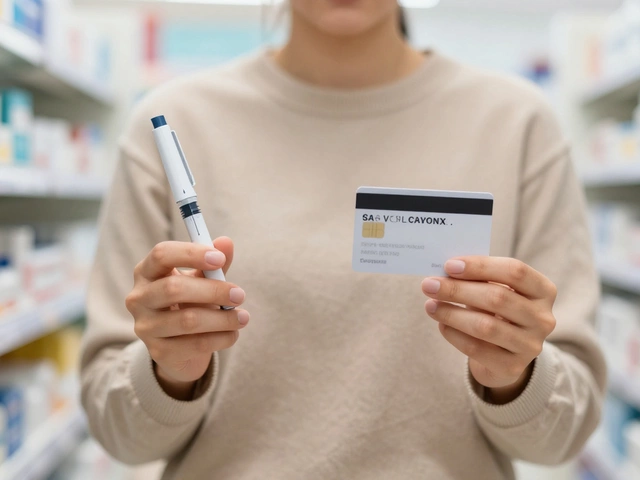If you thought gold was just for jewelry, think again. Ayurveda, India's traditional system of medicine, has been using gold for centuries—not for showing off, but for health. The gold they use isn't just any piece from your grandma’s necklace; it goes through a crazy process that turns regular metal into a powder called Suvarna Bhasma.
People turn to gold in Ayurveda for different reasons—boosting immunity, improving memory, even helping kids grow stronger. But here's the catch: you can't just swallow a gold coin and expect magic. Preparation is everything. We're talking about ancient methods involving fire, herbs, and minerals that sound like something out of a wizard’s playbook. And while old texts make some bold claims, you need to know what actually works and what’s a bad idea.
Gold-based Ayurvedic remedies are still around today, sold in shiny bottles and even recommended by some modern practitioners. But is it safe for everybody? And can it really deliver on those big promises? If you’re thinking about trying gold as medicine because you read about its benefits, there are a few things you should know first. Let’s clear up the confusion and see what this ancient tradition is all about.
- How Gold Made Its Way into Ayurveda
- What Exactly Is Suvarna Bhasma?
- Traditions and Modern Use: Does Gold Still Matter?
- Gold’s Claimed Health Benefits
- Is Gold in Ayurveda Safe?
- Tips for Choosing and Using Gold Remedies
How Gold Made Its Way into Ayurveda
Ever wondered why gold isn’t just locked away in banks or stuck in rings? In Ayurveda, gold has had a spot in medical recipes for a really long time—since at least 2000 years ago. The idea started way back with ancient texts like the Charaka Samhita and Sushruta Samhita, which both mention gold as a way to boost health and energy. These aren’t just dusty old books; they’re pretty much the foundation of Ayurvedic medicine.
Back then, health experts noticed something about gold. They saw that people who wore a lot of gold seemed healthier and lived longer. It doesn’t mean they were superhuman, but it did give ancient doctors a reason to get creative with gold. Instead of just using it as jewelry, they started finding ways to safely put it into medicines. The idea was to tap into gold’s stability and strength, believing it could do the same inside your body if handled the right way.
Some of the earliest records show gold being used to increase stamina, help with mental clarity, and give an overall boost during tough illnesses. It wasn’t just for the rich either; gold was ground down and mixed with other ingredients so that anyone—at least in theory—could access its benefits. In fact, gold became so popular that entire recipes and steps for making gold powder, also called Suvarna Bhasma, were written down and copied for generations.
Here’s a quick look at just how far back gold goes in Ayurveda:
| Ayurvedic Text | Date | Relevance of Gold |
|---|---|---|
| Charaka Samhita | circa 100 BCE | Mentioned gold as a gold in Ayurveda tonic for health and longevity |
| Sushruta Samhita | circa 200 CE | Described gold use in procedures and as a part of healing recipes |
| Rasaratna Samuccaya | around 13th century CE | Gave detailed methods for making gold-based medicines |
So, the next time you see “gold” listed in an Ayurvedic formula, you’ll know it’s not just a marketing gimmick. There’s some real history and old-school science behind it, even if people still argue about what’s fact and what’s hype.
What Exactly Is Suvarna Bhasma?
So, Suvarna Bhasma is the real MVP when it comes to gold in Ayurveda. It’s not some jewelry dust—it's made by burning and treating pure gold with special herbal juices and minerals. This process is called "calcination," and it turns solid gold into a super-fine, almost tasteless powder. This isn’t just for flash: the whole goal is to make gold safe for your body to digest and use, since raw metal would just pass right through you or could be toxic.
Here's how it usually happens:
- Gold is first purified by heating it and dipping it into herbal decoctions.
- The pure gold is then ground down, mixed with plant extracts like aloe or turmeric, and shaped into tiny pellets.
- These pellets are heated at very high temps in clay containers. After each round, more herbs are added and the process repeats. This step goes on for days or weeks.
- The final result is a bright, soft, and very fine gold ash. That’s Suvarna Bhasma.
You might be wondering if it’s just gold dust or something fancier. Suvarna Bhasma has unique physical and chemical properties. Recent studies found that these gold particles are so tiny—often less than 50 nanometers wide. That’s way smaller than anything you see with the naked eye, and experts think this is why the body can absorb it so easily.
| Property | Suvarna Bhasma | Regular Gold |
|---|---|---|
| Particle Size | <50 nanometers | Often >100,000 nanometers |
| Preparation Time | Up to several weeks | Immediate |
| Digestibility | Easily absorbed | Not absorbed |
It’s not just some old-school myth, either. Dr. P.H. Kulkarni, a well-known Ayurveda specialist, says:
"Suvarna Bhasma is mentioned in ancient texts for its potential to support immune strength and vitality, provided it’s prepared with complete care."
But this isn’t a DIY thing you try at home. Ayurvedic doctors spend years learning this process. Quality matters a lot. If it’s not made right, all the supposed benefits pretty much go out the window, and it can even be risky. Always check the source when it comes to gold-based remedies.
Traditions and Modern Use: Does Gold Still Matter?
In ancient times, gold occupied a kind of VIP spot in Ayurveda. It appeared in texts like Charaka Samhita and Rasaratna Samuccaya, listed as an ingredient for tonics that claimed to boost pretty much everything—longevity, energy, brainpower, and even fertility. Gold wasn’t tossed in just for show. Back then, only a few could afford it, so families used it sparingly in special formulas, sometimes as a gift for newborns or those recovering from illness.
Fast forward to today, and gold’s shine in Ayurveda hasn’t totally faded. You’ll still find preparations like Suvarna Bhasma (gold ash) at Ayurvedic pharmacies in India and online. Some clinics, especially those marketing “Rasayana” (rejuvenating) therapies, include gold-based products in their premium sellers. But real gold remedies aren’t cheap. A 2024 survey from an Ayurvedic pharmacy association found that only about 11% of all Ayurvedic medicines sold in India use any kind of gold—so it’s far from mainstream.
What changed? For one, strict regulations. Countries like India set rules about who can prescribe and prepare gold-based Ayurvedic medicine. There are also modern safety concerns, since improper preparation could cause side effects. Plus—not everyone is convinced by the old claims anymore. Some doctors avoid gold, saying the benefits just aren’t proven enough by today’s research. And there’s the price tag: given that gold isn’t getting cheaper, many stick to more common herbal options.
But fans of gold in Ayurveda aren’t giving up. They point to studies showing Suvarna Bhasma could have immune-boosting potential, and a few pilot projects use it for chronic issues. Still, these cases are rare, and most regular folks won’t come across gold-based therapies unless they seek them out.
| Year | % of Ayurveda Prescriptions with Gold | Popular Gold-Based Remedy |
|---|---|---|
| 1980 | ~20% | Suvarna Bhasma |
| 2020 | 11% | Suvarna Prashan (for children) |
| 2024 | 11% | Suvarna Bhasma, Suvarna Prashan |
If you’re curious about gold in Ayurveda, realize it’s a niche tradition today—a kind of luxury in the field. Most people will do just fine with herbal classics, but for some, the gold standard still shines bright.

Gold’s Claimed Health Benefits
So, why would anyone put gold in their body? It comes down to the big promises Ayurveda makes. The most popular form you’ll hear about is called Suvarna Bhasma—basically, ultra-purified gold that's ground into a super fine powder. Traditional texts say it can beef up your immune defenses, make your memory sharper, give you more energy, and even help with fertility issues.
Some modern-day Ayurvedic doctors claim it helps people recover faster from serious illnesses, especially infections and sudden fevers. There are even specific formulas for kids with recurring coughs or for older adults who feel weak and tired all the time.
- Immunity Boost: Used as a tonic to help the body fight infections and recover faster.
- Cognitive Support: Said to help with focus, learning, and memory.
- Energy: Some formulas with gold are given to people who feel exhausted or are healing from major illnesses.
- Child Growth: Very small doses are sometimes included in pediatric tonics to support growth and resilience.
But let’s get real: claims are one thing, proof is another. A few Indian studies found that certain gold formulations could actually boost immune response (measured by a higher white blood cell count), and some lab tests in the last decade saw changes in cell activity when exposed to gold bhasma. But we’re not talking about huge, international clinical trials here—more like small hospital pilot runs.
| Health Benefit | Evidence Level | Notes |
|---|---|---|
| Immunity | Limited human studies | Some small studies showed increased white blood cells |
| Memory | Mainly traditional texts | Minimal clinical support |
| Recovery from illness | Anecdotal & small trials | Improvements mostly reported by patients |
| Child growth | Traditional use | Often part of general health tonics |
If you're thinking about trying any gold remedy, keep expectations realistic. The science isn’t rock-solid, and results can vary a lot from person to person. Always talk to a qualified practitioner before you dive in—especially if you’ve got an allergy, a health issue, or you’re taking other meds. Gold might look glamorous, but it’s not magic dust.
Is Gold in Ayurveda Safe?
Safety is the big question when it comes to gold in Ayurveda. Just because gold’s a precious metal doesn’t mean it’s always safe to use as medicine, right? In Ayurveda, the key is in the preparation. The gold that’s actually used is never raw—it’s processed into something called Suvarna Bhasma (gold ash). The old experts swear that this purified form gets rid of toxins and makes the gold digestible and safe.
But here’s where it gets tricky: the safety totally depends on how carefully it’s made. Studies published by the Indian Journal of Pharmaceutical Sciences and others say that if Suvarna Bhasma is made according to the proper ancient steps, it has no traces of heavy metals or toxic chemicals. But if shortcuts are taken, bad batches can contain dangerous stuff like lead or mercury.
Here’s a quick look at what’s been shown in lab tests:
| Product | Detected Heavy Metals* | Adverse Effects |
|---|---|---|
| Properly Prepared Suvarna Bhasma | None | Rare (mild upset stomach in some cases) |
| Market Samples (poorly regulated) | Lead, Mercury, Arsenic (in some) | Nausea, kidney/liver stress, toxicity |
*Tested by labs in several papers (2017-2022, India). Only certified sources passed consistently.
If you’re interested in gold-based remedies, you really need to know who made it and how. The market is full of fakes and risky knock-offs that just aren’t safe. Several leading doctors in Ayurveda say that gold remedies should only be used under professional supervision and never bought from random online shops or unverified brands.
- Check if the product is from an approved, licensed ayurvedic pharmacy.
- Certifications matter—look for GMP (Good Manufacturing Practice) and lab reports.
- Avoid anyone who tells you to just try gold powder from the jewelry store—big red flag.
Doctors usually recommend these gold-based medicines for specific reasons and only for people who really need them, like those with chronic immunity issues or certain childhood weaknesses. Never take them just for a quick boost; side effects may sneak up, especially if you have allergies or kidney problems. Always talk to an ayurveda-trained doctor before trying anything with gold, even if it's labeled 'natural.'
Tips for Choosing and Using Gold Remedies
Picking an Ayurvedic gold remedy isn’t as simple as shopping for a vitamin. The process is different and, honestly, a bit trickier. Here’s what you need to know before trying anything with Suvarna Bhasma or gold in Ayurveda written on the label.
- Get a trusted brand: Not every seller is honest about what’s actually in their product. Stick with brands known for strict quality control and lab testing. Look for certifications or batch test reports. If a company can’t provide these, walk away.
- Check the preparation method: Authentic gold remedies use a process called “Shodhana” (purification) and “Marana” (incineration) to create fine, absorbable gold particles. Real Suvarna Bhasma is tasteless, reddish, and gets absorbed easily. If it feels gritty or shiny like metal, something’s off.
- Doctor’s advice is a must: Don’t self-medicate. Only a registered Ayurvedic doctor can judge if you need gold-based medicine, how much, and how long to take it. Overdosing or using fake stuff can be harmful for your liver and kidneys.
- Cost can be a clue: Real Suvarna Bhasma is expensive—sometimes over Rs. 800 per 10 mg. If the price is suspiciously low, it’s probably not the real deal or might have dangerous additives.
- Understand the purpose: Gold remedies aren’t general wellness pills. They’re typically used for specific conditions like immune weakness, certain chronic diseases, or during recovery. They're not meant for everyone and not for routine use.
- Watch for side effects: Report problems like nausea, stomach pain, or allergic reactions to your doctor immediately. Your body might not handle processed gold the same way as others.
Some manufacturers add extra herbs, minerals, or even other metals to stretch their product. If you’re on other medicines, be extra careful. Drug interactions aren’t well-studied for these remedies.
| Tip | Why It Matters |
|---|---|
| Only buy lab-tested remedies | Reduces risk of contamination with heavy metals or fake gold |
| Get a proper diagnosis | Avoids unnecessary use and health risks |
| Check patient age | Children and elderly are at higher risk from wrong dosages |
| Follow exact dosage | Prevents toxicity; gold isn’t a ‘more is better’ ingredient |
Bottom line: gold remedies in Ayurveda aren’t a quick fix and definitely not something to try on a whim. If you’re curious or hopeful about any benefits, a real Ayurvedic doctor is your best guide. Never buy anything off the internet without checking—and don’t be swayed by big promises or low prices.







